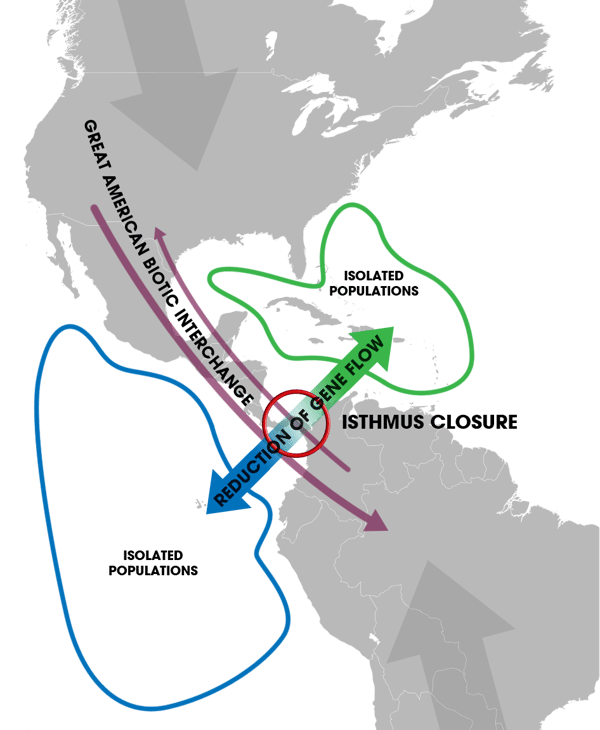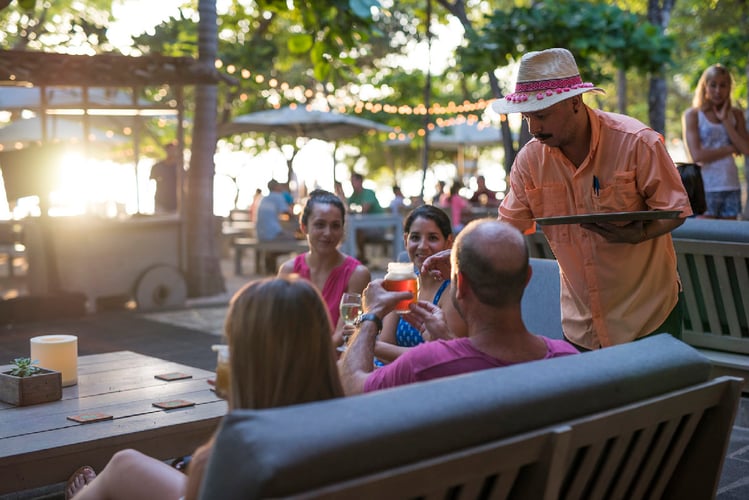The Pre-Costa Rican History of Guanacaste
The area now known as Guanacaste has been a part of Costa Rica in some form since the Anexión del Partido de Nicoya in 1824, just three years after the independence of Costa Rica in 1821.
However, Guanacaste has a history that stretches back long before the region joined Costa Rica. This article focuses on the history of the Guanacaste area between the formation of the Isthmus of Panama more than 4 million years ago and the arrival of the Spanish in 1519.
Pre-Historic Guanacaste | Pre-Chorotega History
Costa Rica has served as a bridge for wildlife and human populations since the combination of volcanic activity and tectonic shifts formed the Isthmus of Panama just south of the region 4 million years ago.
(The creation of the isthmus of Panama caused an isolation of Pacific and Caribbean species, as well as a biotic interchange between South and Central American species | PC: Commons)
However, this small land bridge also served as a natural buffer between groups of Central American origin to the north and groups of South American origin to the south. Human occupation of Guanacaste as we know it now began around 8000 years ago, but there was no defined dominant group for more than 7000 years.
Around 800 A.D., an ethnic group based in the Mangue language left the Soconusco region on the coast of Chiapas (Mexico) and migrated south, fleeing from conquest by a group called the Nahua.
One group of Mangue speakers settled in what was then called Nequepio (in El Salvador), another group of the Mangue speakers settled on what was then called the Gulf of Fonseca coast (in Honduras), and another group continued further south and settled on the Pacific coast of modern day Nicaragua.
From there, this third group of the Mangue speakers spread further south, occupying the Isthmus of Rivas between the Pacific and Lake Nicaragua and then moving through the Pacific Northwest plains of the current province of Guanacaste (in Costa Rica) down to the Gulf of Nicoya.
 As this northern group had been fleeing from conquest by Nahua peoples, they have historically been called chorotegas (from the Nahuatl words choloa, which translates to "run away", and ochololti, which translates to "which undertook the runaway”).
As this northern group had been fleeing from conquest by Nahua peoples, they have historically been called chorotegas (from the Nahuatl words choloa, which translates to "run away", and ochololti, which translates to "which undertook the runaway”).
At the arrival of the chorotegas, there were a number of smaller settlements throughout the Nicoya peninsula, and the mass arrival of the chorotegas displaced many of these groups (like the Diriá and Zapandí) towards the coast. Some others went inland, across the Guanacaste mountain ranges towards the plains of northern Costa Rica, where the mixing of groups gave rise to the Maléku.
Over the course of the next few centuries, it was the chorotegas who became the dominant group in what is now Guanacaste.
(A general map of the autonomous social groups in what would later become Costa Rica | PC: Commons)
Pre-Historic Guanacaste | Chorotega History
The arrival of the chorotegas made the Mesoamerican influence in the region more intense, as this newly formed society began to grow. Populations increased and civilizations became more complex, followed by the slow rise of regional differences.
On a civil scale, villages emerged, with ceremonial buildings made of straw and wood built around a square. Especially along main rivers, such as the Tempisque River and in the coastal valleys, these villages were significant, in some cases covering up to 10 hectares with large populations.

The arrival of the chorotegas led to the expansion of towns and villages, and a a growth of general populations | PC: Commons
 It was around this time that the city of Nicoya began to gain importance within the region, becoming the most populated center in the city and the de facto capital. Other villages, such as Nacazcolo (located on the Papagayo peninsula) and Papagayo (today known as La Cruz), also began to grow in importance through industries like the manufacture of ceramics and salt extraction.
It was around this time that the city of Nicoya began to gain importance within the region, becoming the most populated center in the city and the de facto capital. Other villages, such as Nacazcolo (located on the Papagayo peninsula) and Papagayo (today known as La Cruz), also began to grow in importance through industries like the manufacture of ceramics and salt extraction.
Culturally, the chorotegas introduced changes in societal structure, religious ideology, art, and architecture. The rise of the chorotegas was also accompanied by a shift in society on the Nicoya Peninsula, which became more hierarchical, with social differences accentuated. The villages were ruled by a king and a group of principals (or galpones) and the priestly class was strengthened.
The religious beliefs brought down from Central America took hold as well. Human sacrifice and ritual anthropophagy were introduced, in line with the ancient Mesoamerican beliefs. In the ceramics built around this time, Mesoamerican motifs and deities such as Tezcatlipoca, Quetzacóatl and Xipe Totec began to appear. Circular temples represented one of many shifts in the architectural style.
The final changes to society centered around the rise of external trade. The chorotegas made advancements in textiles, whose fabrics were dyed using snail shells. Trade routes and relationships were formed with populations of El Salvador, Honduras, Guatemala and Mexico, which continued Nicoya’s economic growth due to the quality and finish of its pottery, which went into high demand around the continent.
By the 1500s, the chorotegas had become the predominant economic and cultural presence on the Nicoya peninsula, and as a result became the primary civilization in the area that interacted with the Spanish upon their arrival in Central America. (Nicoya Pottery was well renowned for its quality and finish, helping contribute to this area's growth | PC: Commons)
See Pre-Chorotega and Chorotega History in Guanacaste
An exhibition on the pre-history of Guanacaste is now open to the public at the Jicaro Valley exhibit in the Museo de Guanacaste in Liberia. This collection is centered around the transition period during which the chorotegas were arriving and settling in the Guanacaste region, and as a result features pottery and artifacts with information on both periods (pre chorotega and chorotega).
Concierge can arrange a guided tour through the museum, for an in-depth look at the customs and lives of the Guanacaste area during this time of change in pre-hispanic Costa Rica’s period.
(The Museo de Guanacaste in Liberia hosts an exhibition on the Jicaro Valley during the arrival of the chorotegas in Costa Rica | PC: Commons)




